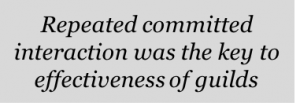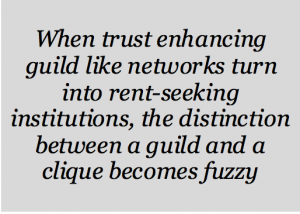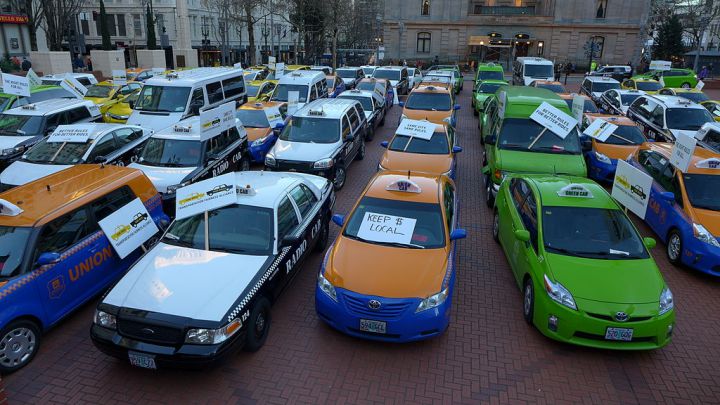Close-knit networks, like guilds and taxi associations, are helpful in enhancing trust and reliability. Yet they can also become exclusive and rent-seeking.
Last May, ride-hailing companies Lyft and Uber stopped their operations in Austin, Texas, following a long standoff with the city council of Austin regarding the limits of peer-to-peer taxi regulation.
The Austin standoff revolved around a contentious issue: should Lyft and Uber drivers be vetted through fingerprinting? The people of Austin voted in agreement, defeating a proposition that would have overturned a bill requiring drivers to undergo mandatory fingerprint-based background checks. The ride-hailing companies thought the regulations didn’t allow “true ride-sharing to operate.” In contrast, the city council and a majority of voters thought the regulations made the services safer.
The episode highlighted the contentious relationship that exists between regulation and reliability.
Networks of business
Finding reliable partners has always been a challenge for businessmen. Until the modern era, business was almost exclusively conducted through reliable networks. These networks could be organized around ties of kinship, like the clan system in China, or around clubs of shared interest, like the merchant guild system in Europe.
 Doing business through networks allowed businessmen to keep a record of reputation. If someone cheated, others in the network could know and relay this information. Networks made reputation a valuable capital in itself.
Doing business through networks allowed businessmen to keep a record of reputation. If someone cheated, others in the network could know and relay this information. Networks made reputation a valuable capital in itself.
Not surprisingly, networks still matter today. Clan-like systems are still relevant in developing countries (e.g., caste networks in India), and guild-like systems still find modern parallels in associations of taxi drivers or real estate brokers. Moreover, research by sociologists such as Ronald S. Burt of the University of Chicago has shown that networks are sources of strategic advantage and they aid in brokering and creating new ideas.
One prominent example of a region benefiting from its unique, loosely linked network structure is Silicon Valley, which stood in contrast to the more rigid and closed network structure of the rival technology cluster in the Boston area.
The value of merchant guilds
The merchant guild system was a unique non-kinship-based way of organizing business in medieval and early modern Europe, which solved the problem of trustworthy exchange.
 Stanford economic historians Grief, Milgrom and Weingast (1994) argued that merchant guilds provided members with a united platform, where they could collectively assert their rights and sanction opportunists. While the merchant (and craft) guild system provided several benefits to members, the effect of guilds on non-members is controversial. Repeated committed interaction was the key to the effectiveness of guilds. As uncommitted newcomers could behave opportunistically and undermine the system, so newcomers faced restrictions. At the same time, these newcomers also threatened the position of incumbent businessmen by increasing competition.
Stanford economic historians Grief, Milgrom and Weingast (1994) argued that merchant guilds provided members with a united platform, where they could collectively assert their rights and sanction opportunists. While the merchant (and craft) guild system provided several benefits to members, the effect of guilds on non-members is controversial. Repeated committed interaction was the key to the effectiveness of guilds. As uncommitted newcomers could behave opportunistically and undermine the system, so newcomers faced restrictions. At the same time, these newcomers also threatened the position of incumbent businessmen by increasing competition.
Thus, even genuinely committed newcomers could be restricted upon entry, as they threatened the domination of existing members. Historians like Sheilagh Ogilvie at the University of Cambridge have emphasized this temptation for domination in guilds. Ogilvie argued that guilds became exclusive, privileged monopolies with high barriers to entry for newcomers.
These charges echo the charges that have been leveled against taxi unions in recent years, due to their attempts to restrict the rise of ride-hailing apps like Lyft and Uber.
Clubs or Cliques?
The role of merchant guild-like networks is twofold:
- On the one hand, they serve a trust-enhancing purpose of enabling reliable business interactions.
- On the other hand, the same networks could motivate members into rent-seeking behavior by building explicit and not-so-explicit barriers to entry.
 When trust-enhancing guild-like networks turn into rent-seeking institutions, the distinction between guilds and cliques becomes fuzzy. In his book Making Democracy Work (Princeton University Press, 1994), Harvard sociologist Robert Putnam
When trust-enhancing guild-like networks turn into rent-seeking institutions, the distinction between guilds and cliques becomes fuzzy. In his book Making Democracy Work (Princeton University Press, 1994), Harvard sociologist Robert Putnam
argued that voluntary guild-like networks emerged during the early period of the second millennium in Northern Italy. These early guilds were portrayed like clubs, which became teaching grounds of civic culture.
Thus, historically, guilds that were once formed by locals as a trust-enhancing club open for membership eventually became exclusive and began to look more like cliques helping just a privileged few during the early modern period.
Lessons from the taxi business
The taxi industry can shed light on the behavior of guilds, and on this delicate balance between trust enhancement and collection of rents.
The taxi industry has been regulated for a very long time. This regulation served a utility: Just like guilds, taxi regulation ensured that taxi drivers were reliable and offered a high quality of service.
While taxi regulation solved the problem of reliability in the past, the modern IT revolution has provided a new paradigm for solving reliability problems. Now, trusting a taxi driver is less of an issue, as the GPS system makes the cars and the routes closely monitorable.
Due to this technological shift, the same regulated taxi services that were once highly admired and reputed for their trust-enhancing service, like the London Taxi Company, are now being excoriated as being overpriced, as customers no longer value their gold-standard reliability. Instead of trusting a licensed taxi, customers today like to tap a button and hail a Lyft or an Uber. As taxi regulation no longer remains as valuable as in the past, these iconic taxi unions are viewed as anti-customer and rent-seekers whenever they try restricting the introduction of Lyft and Uber-like taxi services.
This creates a dichotomy: the same licensed taxi service can at once be considered as providing a vital, admired, and reliable service, and also be castigated as being an anti-customer clique.
Whether it be the past or the present, guilds or taxi associations, corporations or start-ups, conducting business has always involved both fear and greed. The same guild-like networks that can resolve the fear that businessmen and customers have regarding the reliability of their partners, can also provide a platform for businessmen with rent-seeking temptations to gain influence in the markets.
By the beginning of the modern era in the sixteenth century, the monopoly of guilds started getting dismantled, especially in the Low Countries and England. In its place, the first capitalist markets of the kind we are so used to today began to rise. Adam Smith, who was highly critical of the guild system and its closed membership, instead propounded ideas of free market.
Is Uber the free market solution to the centuries-old problem of finding reliable transportation, a problem that until now needed licensed taxis? The answer to this question is not so simple. While Uber looks like a disruptive startup today, it too can morph into a dissatisfying monopoly, its freedom rejected and regulated by voters, like those in Austin. Given that business is driven by both fear and greed, the debate over how to keep markets free, and out of cronyist control, continues to rage.






